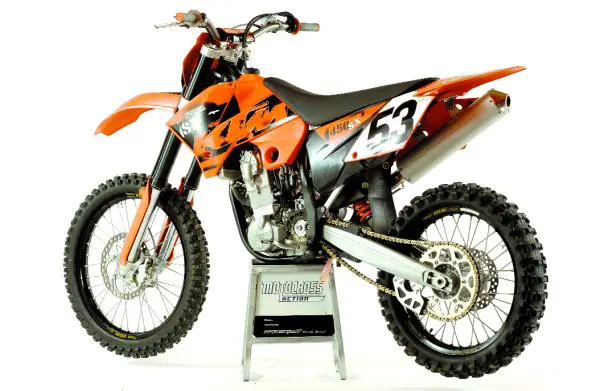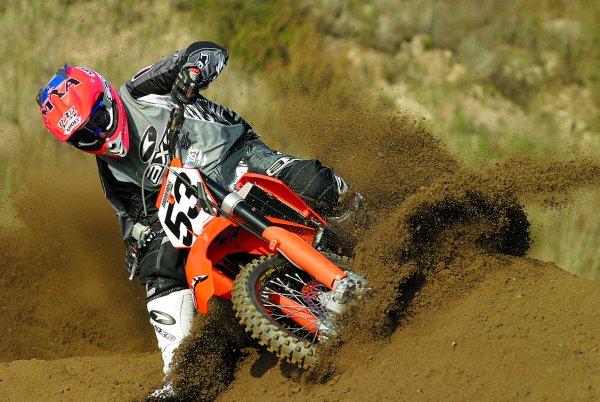MXA’S 2006 KTM 450SXF TEST
Have you heard of Maico? Bultaco? BSA? Ossa? Montesa? CZ? Rickman? Sure you have, but they’re only discussed when the subject of defunct European motorcycle brands is brought up. KTM was a contemporary of those dear departed brands, yet it is still standing, still in business, and still fighting the good fight. The Japanese industrial juggernaut of the late ?70s wiped most European motorcycle companies off the face of the earth, but KTM withstood the onslaught.
How did they survive when all those around them fell? That’s simple. KTM wasn’t an Old World cottage business. KTM didn’t shuttle parts from one department to the next in wooden boxes that had seen horse drawn carts in an earlier life. KTM wasn’t a gunsmith that became a motorcycle manufacturer during the machine age. No, KTM was the newest of the European builders when Honda, Yamaha, Suzuki and Kawasaki came on the scene. Not saddled by old factories, aging employees and blacksmith equipment, KTM was well equipped to fight back.

KTM has prospered because they were ready, willing and able to produce what the consumer of the future wantednot what the consumer of the past bought. That is why KTM has stayed competitiveand why the 2006 KTM 450SXF is worth looking at.
Q:IS THE 2006 KTM 450SXF REALLY DIFFERENT FROM THE ?05 MODEL?
A:Not really. The major changes are invisible to the consumer because they are structural mods to the frame. KTM’s goal over the last two seasons has been to increase frame rigidity. Last year, they focused on the swingarm pivot area, and this year on the head tube.
The most noticeable update is the new, one-piece swingarm.
Q:IS THE 2006 450SXF FASTER THAN LAST YEAR’S 450SXF?
A:No, and for good reason. Mechanically, the 2006 engine is the 2005 engine (which was the 2004 engine). The crankshaft has been beefed up again (KTM is very fond of making crankshaft changes), but there is no need to notify the National Enquirer about the differences.
Q:HOW FAST IS THE 2006 KTM 450SXF?
A:We loved this engine. No surprise there, because we loved it last year and it is basically unchanged. What is surprising is that the KTM 450SXF is not all that fast. This isn’t a rock ?em, sock ?em, barn burner of an engine. It doesn’t have the raw torque of the KX450F, the solid vibes of the CRF450, the throttle response of the RM-Z450 or the joie de vivre of the YZ450F. But what is does have is a malleable powerband that answers every call to action.
Q:WHAT IS A MALLEABLE POWERBAND?
A:By malleable we mean that the KTM’s broad, easy-to-use, and pleasant output can be snoozed, cruised or juiced. It will do whatever you want it to do. It is versatile. Need examples?
(1) A Novice can ride it at five-tenths without a sputter or a bog. It won’t scare him or jerk his arms out of their sockets. It has nice roll-on power and a long steady pull. It is comforting to ride if you are new to the world of big-bore four-strokes.
(2) An Intermediate can charge down the straights at eight-tenths and still find the power manageable when the speed gets sketchy. KTM has built an engine that runs like a thoroughbred; it can gallop without breathing hard, but responds to the whip with rapid acceleration.
(3) A Pro can hammer the KTM 450SXF at ten-tenths and get more out of it than he might on a bike with a harder hit or more violent pull. We aren’t going to pull the wool over your eyes and tell you that this is a Pro engineit’s not. But speed doesn’t always come from Abrams tank torque or F22 Raptor revsometimes it is the product of making the most of just the right amount of power.

Q:WHICH SKILL LEVEL WILL GET THE MOST OUT OF THE 450SXF?
A:That’s easy. Although every skill level of MXA test rider liked the 450SXF powerband, it is best suited to Vet riders and those undecided riders who are trying to choose between a 450 four-stroke and a 250 four-stroke. The 450SXF splits the difference.
Q:IS THERE AN EASY WAY TO MAKE THE KTM 450SXF MORE POWERFUL?
A:Yes. Buy the KTM 525SXF. It’s a torque monster.
Q:WHAT ARE THE PLUSES AND MINUSES OF A FOUR-SPEED GEARBOX?
A:Nothing is more controversial in the world of 450cc motocross bikes than the four-speed gearbox. Suzuki, Kawasaki and KTM have four on the floor, while Yamaha and Honda have five-speeders. The MXA wrecking crew didn’t need to take a poll to find out that American riders prefer five speeds over four. It might have something to do with the Spinal Tap Syndrome (“This amp goes to 11”), but, for all-around riding, five nicely spaced gears give a talented rider the opportunity to focus available power into bite-sized chunks. That’s a good thing!
As for the current crop of four-speeds, we think that the KX450F’s gearbox is poorly conceived. First gear is too low and second, third and fourth are too widely spaced, leaving the KX450F rider with a three-speed at best.
Suzuki’s take on the four-speed is much better than Kawasaki’s, but hampered by their insistence on gearing the bike too high. Over gearing a four-speed is normally caused by “fifth-gear envy.” What is that? Fifth gear envy is when the engineers gear the whole gearbox taller to insure that top speed doesn’t suffer in comparison to the top gear on a five-speed. In the process, second and third become very lackadaisical. That is the RM-Z’s situation.
Of all the four-speeds, the KTM 450SXF’s is the best. It has gear ratios that are well mated to the Katoom’s power output. Each gear falls readily at hand when its time to shine comes.
Q:WOULD THE KTM 450SXF BE BETTER IF IT HAD A FIVE-SPEED?
A:Yes, the 2006 model would be better with a five-speed. Closer ratios would make the KTM’s mellow powerband more focused.
Q:HOW DO THE 2006 KTM 450SXF FORKS WORK?
A:The MXA wrecking crew has badmouthed WP forks for as long as we can remember. We argued about settings with White Power’s Henk Thuis years before the name was changed to a more politically correct WP. Henk was a nice guy, but his understanding of the suspension needs of American riders was limited. When KTM bought WP, the MXA gang thought that new blood would infuse the Dutch-built forks with better settings. It didn’t happen overnight, but in 2005 WP finally got its act together, and the 2006 forks are night-and-day better than the torture devices that WP foisted on us for the last 20 years.
Good forks. We congratulate KTM for finally getting it right. As for settings, we ran the fork caps 5mm up in the triple clamps. Our best clicker settings were with the compression on 16 clicks out and the rebound at 18 clicks.
Q:WHAT ABOUT KTM’S WP/OHLINS PDS SHOCK?
A:Ohlins designed the WP shock to work with KTM’s no-link rear suspension. The core ingredient of the Ohlins-licensed technology is the dual-piston damping. One internal shock piston is speed-sensitive (responsive to shock shaft movement), while the other piston is position-sensitive (activated when the shock compresses a predetermined amount). This dual-piston concept allows the speed-sensitive piston to meter the damping based on the force directed into the shock by bumps and jumps, while the position-sensitive piston kicks in when the rear wheel travels high into the stroke.
How does it work? It is adequate. Not great. Not atrocious. Not as bad as KTM’s suspension from three or four years ago. The MXA test crew set the high-speed compression at 2-1/2 turns out, the low-speed compression at 14 clicks and the rebound on 25. We tested sag settings as low as 110mm and as high as 100mm. We opted for 105 to keep the chassis more balanced. Too much race sag causes the front end to push at turn-in. Making the rear of the frame 30 percent stiffer last year and stiffening the swingarm this year makes the rear of the KTM actually want to work.
Our only consistent complaint came in low-speed/high-load situations. The WP shock would G-out when the shock was traveling at slow shaft speeds, but with a lot of down force from the rider. We’ve seen this problem before, and it is typically caused by rising rate deficiencies more than valving stacks.
Q:HOW DOES IT HANDLE?
A:KTM outfits every one of their bikes with adjustable offset triple clamps. Although they roll off the assembly line with 20mm of offset, the MXA test crew prefers 18mmespecially on the big four-strokes (we don’t worry too much about offset changes on the 125SX or 250SXF).
We heartily recommend 18mm offset. It makes the KTM 450SXF into a decent handling machine. The front end sticks better than any KTM in the past. The tendency to understeer is greatly reduced (KTM credits the stiffer steering tube for this) and, for the first time in years, not a single MXA test rider made a face when asked about the big Katoom’s cornering prowess.
Q:WHAT DID WE HATE?
A:The hate list:
(1) Fenders: We wish there was a nice way to say this, but there isn’t. The fenders are ugly.
(2) Triple clamps: We wish KTM would set the offset on the 450SXF on 18mm instead of 20. It’s a hassle to swap it over in the garage.
(3) Gas tank: The 250SXF has a cool aircraft-style fuel cap, but the 450SXF gets the old tank with the teeny-weenie gas filler cap.
(4) Rims: Black rims are hip, but after a few months of rock dings and tire changes, they look like Dalmatian rims.
(5) Side panels: The numbers don’t fit on the number plateswhich means that they aren’t really number plates.
Q:WHAT DID WE LIKE?
A:The like list:
(1) Handlebars: Oversize Renthal FatBars. Sweet!
(2) Triple clamps: The CNC-machined triple clamps have four-position adjustable bar mounts and two-way adjustable offset. Awesome!
(3) Clutch: Magura’s hydraulic clutch is good, but the 250SX has a new Brembo unit that is even better. The Brembo clutch uses DOT 5.1 brake fluid instead of the Magura’s mineral oil.
(4) Hot start: KTM moved the hot start to the handlebars for ’06. It was mounted on the carb last year.
(5) Brakes: The best front brake in the motocross world. Pucker power!
(6) Tires: We don’t know how they did it, but KTM managed to bypass all of Bridgestone’s less-than-stellar new stuff and get the 450SXF shod with the old-school M59/M70 combo. The tires work best on intermediate-to-soft terrain.
(7) Swingarm: Take a close look at the 2006 KTM swingarm. It is one-piece. No welding. No bonding. No seams. The swingarm is cast with internal gusseting that eliminates any unequal flex. Very trick.
Q:WHAT DO WE REALLY THINK?
A:Are you ready? Wait for it. Here it comes. This is a really good 450cc four-stroke. So good that a fair share of MXA test riders would choose it over several Japanese-built thumpers. If this bike wasn’t on your Christmas list, don’t worry, tax time is coming up and you can use your return to make amends. Worth considering.
For more 2006 Bike Tests go to Top Ten Stories





Comments are closed.